Applying Systems Thinking to Solve Domestic Violence Issues
VerifiedAdded on 2020/02/24
|12
|3121
|38
Essay
AI Summary
This essay delves into the complex issue of domestic violence, employing systems thinking as a framework for analysis and solution development. The paper begins with an introduction to systems thinking, contrasting it with traditional approaches and highlighting its suitability for tackling "wicked problems." The core of the essay focuses on applying the iceberg model to understand domestic violence, examining events, patterns, structures, and mental models. The analysis explores the multifaceted nature of domestic violence, considering factors such as societal structures, gender dynamics, and individual behaviors. The essay then assesses the extent to which systems thinking can effectively address this issue, comparing it with the limitations of current approaches. The conclusion summarizes the effectiveness of systems thinking in addressing domestic violence and suggests strategies for prevention and intervention, emphasizing the need for a comprehensive, multi-level approach to mitigate this societal problem.
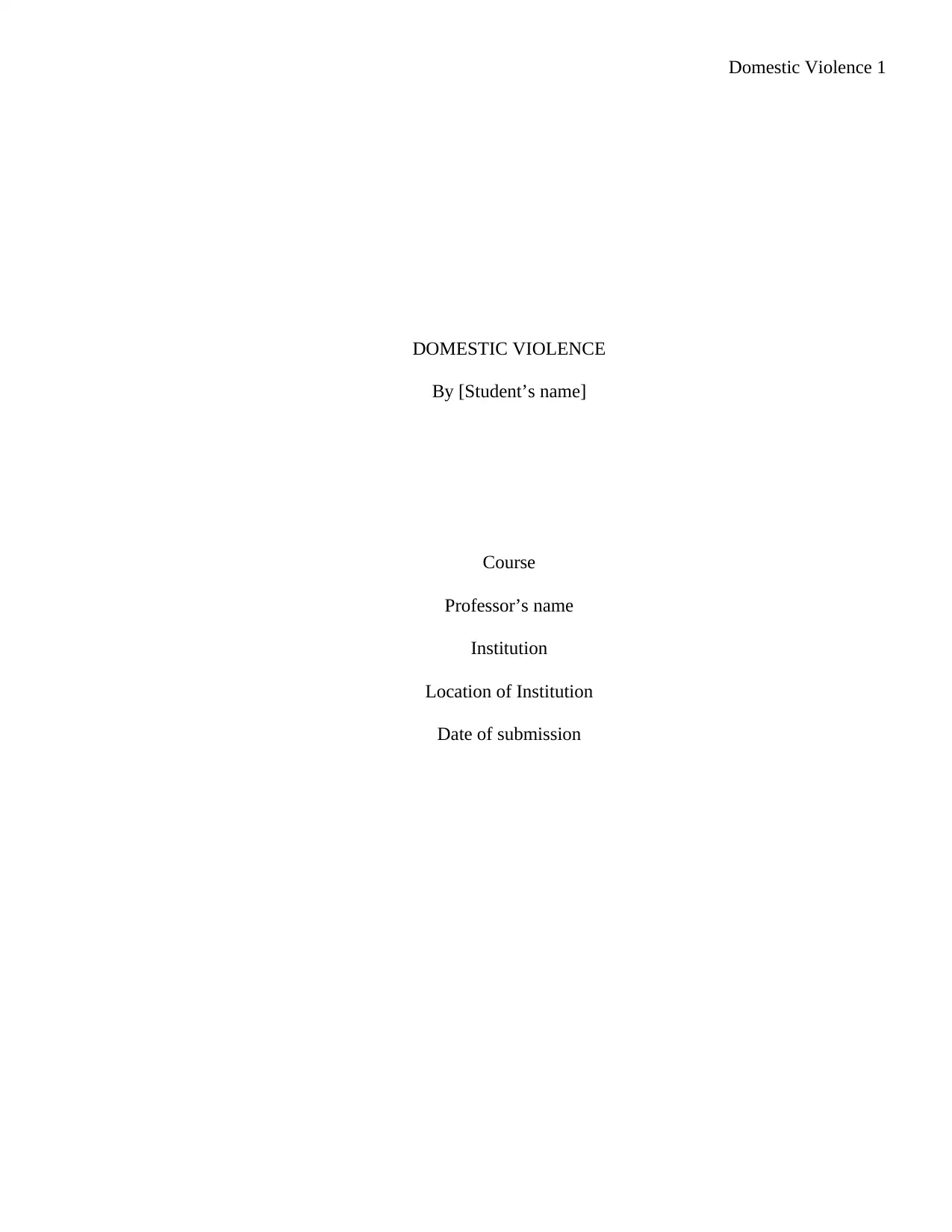
Domestic Violence 1
DOMESTIC VIOLENCE
By [Student’s name]
Course
Professor’s name
Institution
Location of Institution
Date of submission
DOMESTIC VIOLENCE
By [Student’s name]
Course
Professor’s name
Institution
Location of Institution
Date of submission
Paraphrase This Document
Need a fresh take? Get an instant paraphrase of this document with our AI Paraphraser
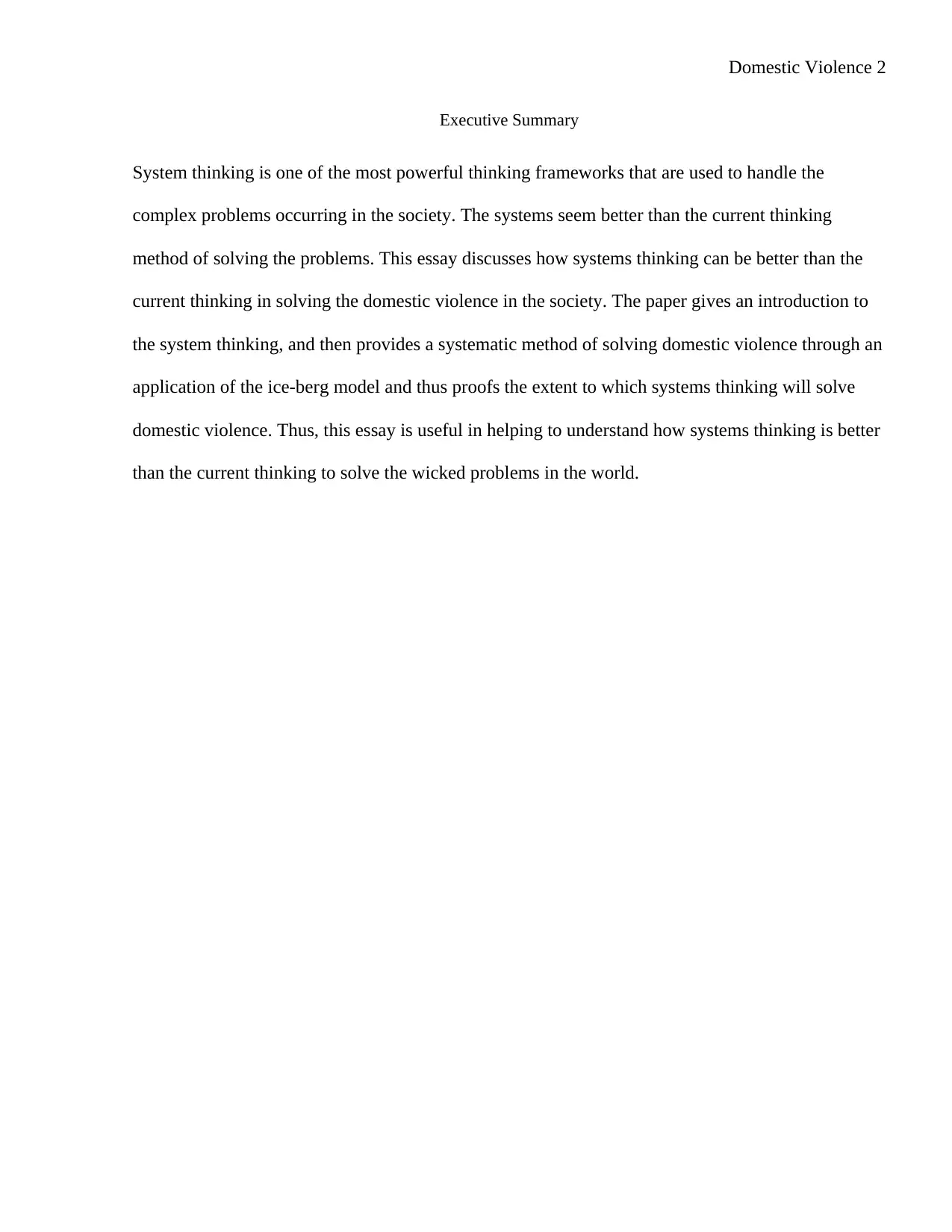
Domestic Violence 2
Executive Summary
System thinking is one of the most powerful thinking frameworks that are used to handle the
complex problems occurring in the society. The systems seem better than the current thinking
method of solving the problems. This essay discusses how systems thinking can be better than the
current thinking in solving the domestic violence in the society. The paper gives an introduction to
the system thinking, and then provides a systematic method of solving domestic violence through an
application of the ice-berg model and thus proofs the extent to which systems thinking will solve
domestic violence. Thus, this essay is useful in helping to understand how systems thinking is better
than the current thinking to solve the wicked problems in the world.
Executive Summary
System thinking is one of the most powerful thinking frameworks that are used to handle the
complex problems occurring in the society. The systems seem better than the current thinking
method of solving the problems. This essay discusses how systems thinking can be better than the
current thinking in solving the domestic violence in the society. The paper gives an introduction to
the system thinking, and then provides a systematic method of solving domestic violence through an
application of the ice-berg model and thus proofs the extent to which systems thinking will solve
domestic violence. Thus, this essay is useful in helping to understand how systems thinking is better
than the current thinking to solve the wicked problems in the world.
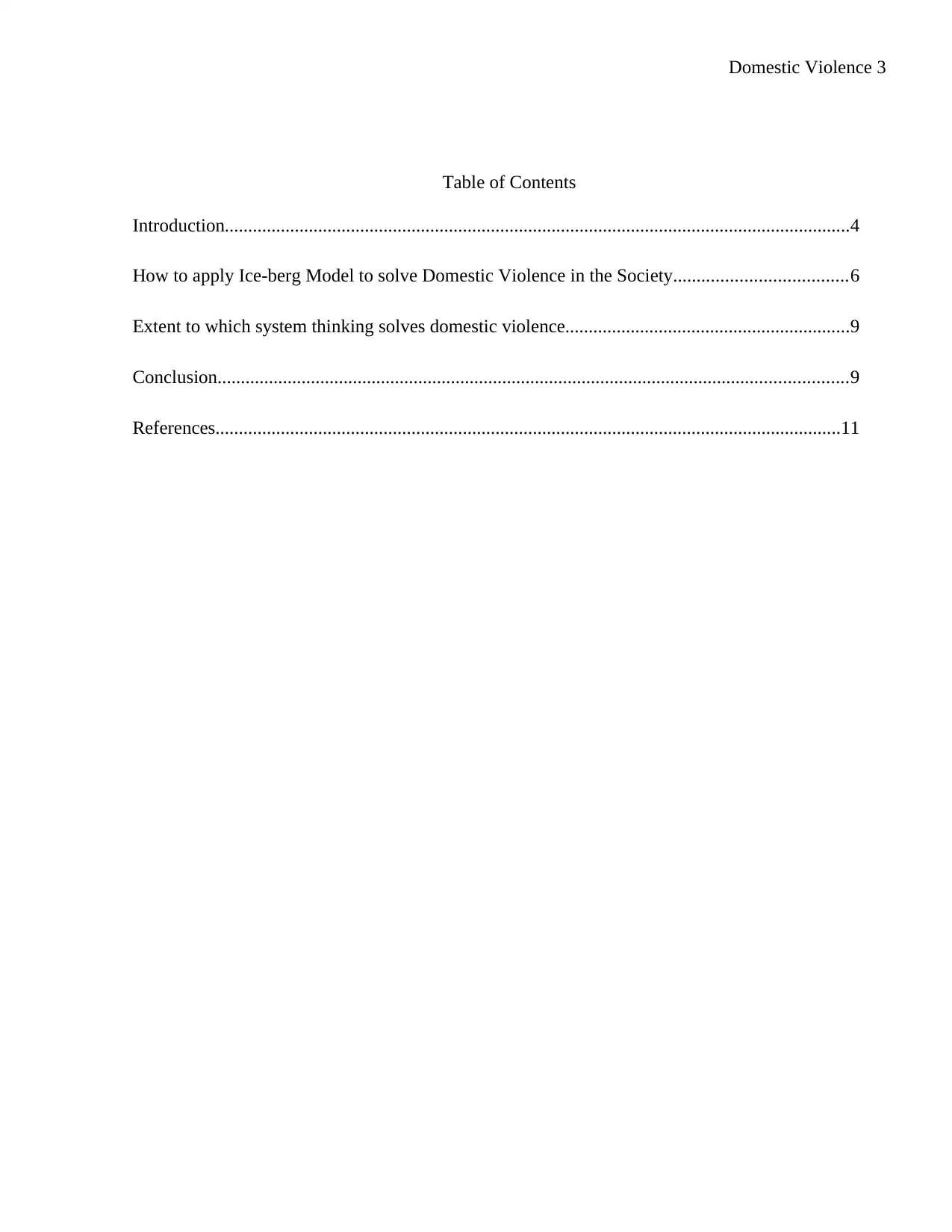
Domestic Violence 3
Table of Contents
Introduction......................................................................................................................................4
How to apply Ice-berg Model to solve Domestic Violence in the Society.....................................6
Extent to which system thinking solves domestic violence.............................................................9
Conclusion.......................................................................................................................................9
References......................................................................................................................................11
Table of Contents
Introduction......................................................................................................................................4
How to apply Ice-berg Model to solve Domestic Violence in the Society.....................................6
Extent to which system thinking solves domestic violence.............................................................9
Conclusion.......................................................................................................................................9
References......................................................................................................................................11
⊘ This is a preview!⊘
Do you want full access?
Subscribe today to unlock all pages.

Trusted by 1+ million students worldwide
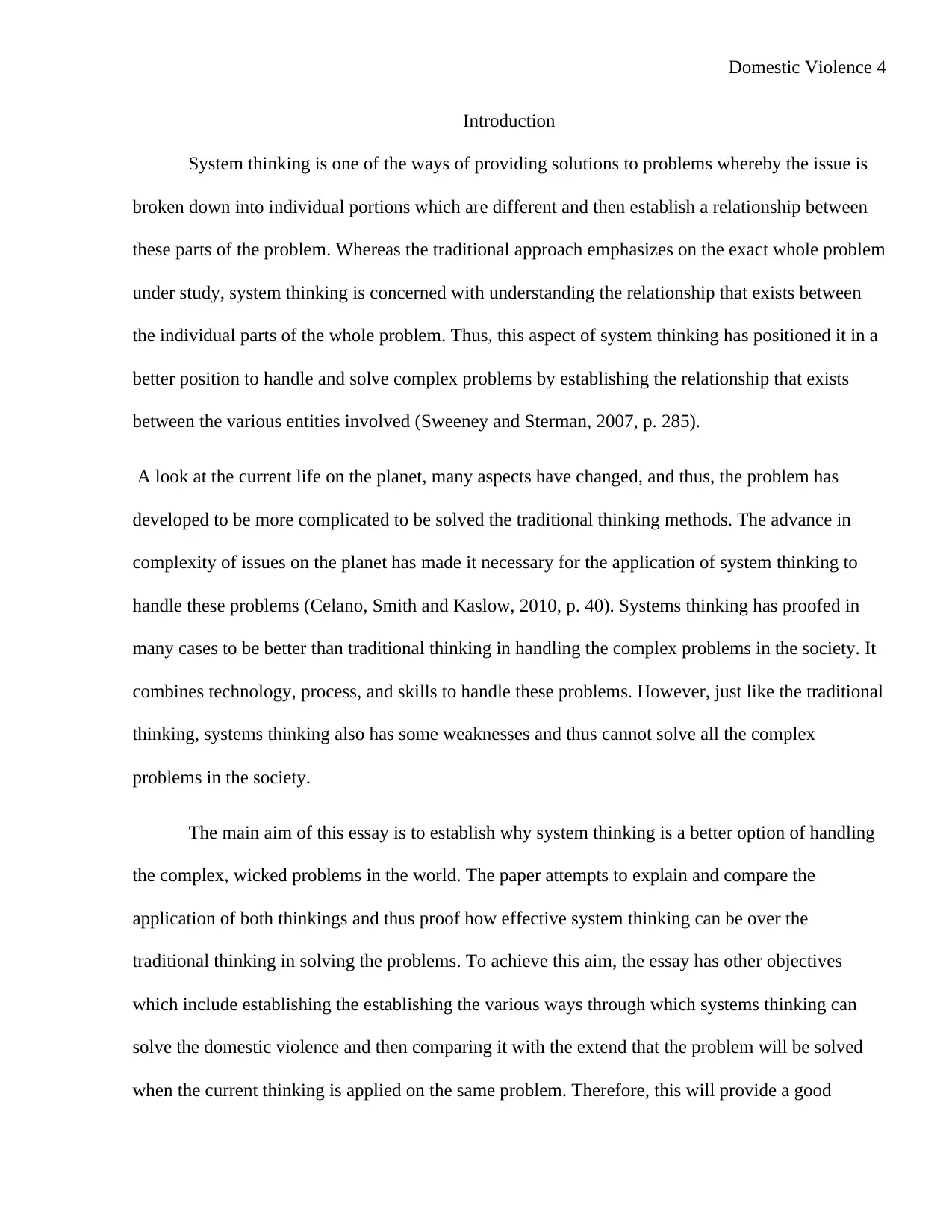
Domestic Violence 4
Introduction
System thinking is one of the ways of providing solutions to problems whereby the issue is
broken down into individual portions which are different and then establish a relationship between
these parts of the problem. Whereas the traditional approach emphasizes on the exact whole problem
under study, system thinking is concerned with understanding the relationship that exists between
the individual parts of the whole problem. Thus, this aspect of system thinking has positioned it in a
better position to handle and solve complex problems by establishing the relationship that exists
between the various entities involved (Sweeney and Sterman, 2007, p. 285).
A look at the current life on the planet, many aspects have changed, and thus, the problem has
developed to be more complicated to be solved the traditional thinking methods. The advance in
complexity of issues on the planet has made it necessary for the application of system thinking to
handle these problems (Celano, Smith and Kaslow, 2010, p. 40). Systems thinking has proofed in
many cases to be better than traditional thinking in handling the complex problems in the society. It
combines technology, process, and skills to handle these problems. However, just like the traditional
thinking, systems thinking also has some weaknesses and thus cannot solve all the complex
problems in the society.
The main aim of this essay is to establish why system thinking is a better option of handling
the complex, wicked problems in the world. The paper attempts to explain and compare the
application of both thinkings and thus proof how effective system thinking can be over the
traditional thinking in solving the problems. To achieve this aim, the essay has other objectives
which include establishing the establishing the various ways through which systems thinking can
solve the domestic violence and then comparing it with the extend that the problem will be solved
when the current thinking is applied on the same problem. Therefore, this will provide a good
Introduction
System thinking is one of the ways of providing solutions to problems whereby the issue is
broken down into individual portions which are different and then establish a relationship between
these parts of the problem. Whereas the traditional approach emphasizes on the exact whole problem
under study, system thinking is concerned with understanding the relationship that exists between
the individual parts of the whole problem. Thus, this aspect of system thinking has positioned it in a
better position to handle and solve complex problems by establishing the relationship that exists
between the various entities involved (Sweeney and Sterman, 2007, p. 285).
A look at the current life on the planet, many aspects have changed, and thus, the problem has
developed to be more complicated to be solved the traditional thinking methods. The advance in
complexity of issues on the planet has made it necessary for the application of system thinking to
handle these problems (Celano, Smith and Kaslow, 2010, p. 40). Systems thinking has proofed in
many cases to be better than traditional thinking in handling the complex problems in the society. It
combines technology, process, and skills to handle these problems. However, just like the traditional
thinking, systems thinking also has some weaknesses and thus cannot solve all the complex
problems in the society.
The main aim of this essay is to establish why system thinking is a better option of handling
the complex, wicked problems in the world. The paper attempts to explain and compare the
application of both thinkings and thus proof how effective system thinking can be over the
traditional thinking in solving the problems. To achieve this aim, the essay has other objectives
which include establishing the establishing the various ways through which systems thinking can
solve the domestic violence and then comparing it with the extend that the problem will be solved
when the current thinking is applied on the same problem. Therefore, this will provide a good
Paraphrase This Document
Need a fresh take? Get an instant paraphrase of this document with our AI Paraphraser
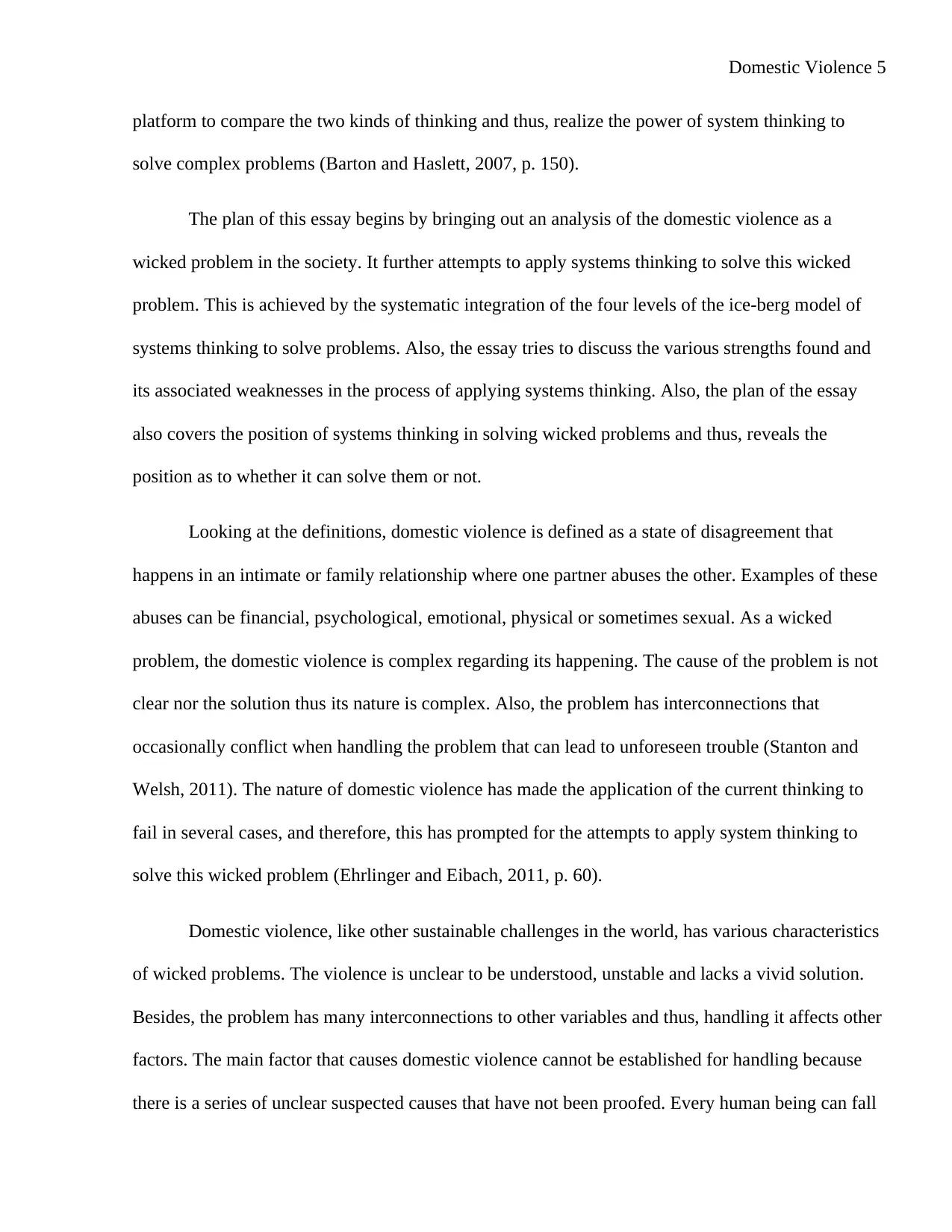
Domestic Violence 5
platform to compare the two kinds of thinking and thus, realize the power of system thinking to
solve complex problems (Barton and Haslett, 2007, p. 150).
The plan of this essay begins by bringing out an analysis of the domestic violence as a
wicked problem in the society. It further attempts to apply systems thinking to solve this wicked
problem. This is achieved by the systematic integration of the four levels of the ice-berg model of
systems thinking to solve problems. Also, the essay tries to discuss the various strengths found and
its associated weaknesses in the process of applying systems thinking. Also, the plan of the essay
also covers the position of systems thinking in solving wicked problems and thus, reveals the
position as to whether it can solve them or not.
Looking at the definitions, domestic violence is defined as a state of disagreement that
happens in an intimate or family relationship where one partner abuses the other. Examples of these
abuses can be financial, psychological, emotional, physical or sometimes sexual. As a wicked
problem, the domestic violence is complex regarding its happening. The cause of the problem is not
clear nor the solution thus its nature is complex. Also, the problem has interconnections that
occasionally conflict when handling the problem that can lead to unforeseen trouble (Stanton and
Welsh, 2011). The nature of domestic violence has made the application of the current thinking to
fail in several cases, and therefore, this has prompted for the attempts to apply system thinking to
solve this wicked problem (Ehrlinger and Eibach, 2011, p. 60).
Domestic violence, like other sustainable challenges in the world, has various characteristics
of wicked problems. The violence is unclear to be understood, unstable and lacks a vivid solution.
Besides, the problem has many interconnections to other variables and thus, handling it affects other
factors. The main factor that causes domestic violence cannot be established for handling because
there is a series of unclear suspected causes that have not been proofed. Every human being can fall
platform to compare the two kinds of thinking and thus, realize the power of system thinking to
solve complex problems (Barton and Haslett, 2007, p. 150).
The plan of this essay begins by bringing out an analysis of the domestic violence as a
wicked problem in the society. It further attempts to apply systems thinking to solve this wicked
problem. This is achieved by the systematic integration of the four levels of the ice-berg model of
systems thinking to solve problems. Also, the essay tries to discuss the various strengths found and
its associated weaknesses in the process of applying systems thinking. Also, the plan of the essay
also covers the position of systems thinking in solving wicked problems and thus, reveals the
position as to whether it can solve them or not.
Looking at the definitions, domestic violence is defined as a state of disagreement that
happens in an intimate or family relationship where one partner abuses the other. Examples of these
abuses can be financial, psychological, emotional, physical or sometimes sexual. As a wicked
problem, the domestic violence is complex regarding its happening. The cause of the problem is not
clear nor the solution thus its nature is complex. Also, the problem has interconnections that
occasionally conflict when handling the problem that can lead to unforeseen trouble (Stanton and
Welsh, 2011). The nature of domestic violence has made the application of the current thinking to
fail in several cases, and therefore, this has prompted for the attempts to apply system thinking to
solve this wicked problem (Ehrlinger and Eibach, 2011, p. 60).
Domestic violence, like other sustainable challenges in the world, has various characteristics
of wicked problems. The violence is unclear to be understood, unstable and lacks a vivid solution.
Besides, the problem has many interconnections to other variables and thus, handling it affects other
factors. The main factor that causes domestic violence cannot be established for handling because
there is a series of unclear suspected causes that have not been proofed. Every human being can fall
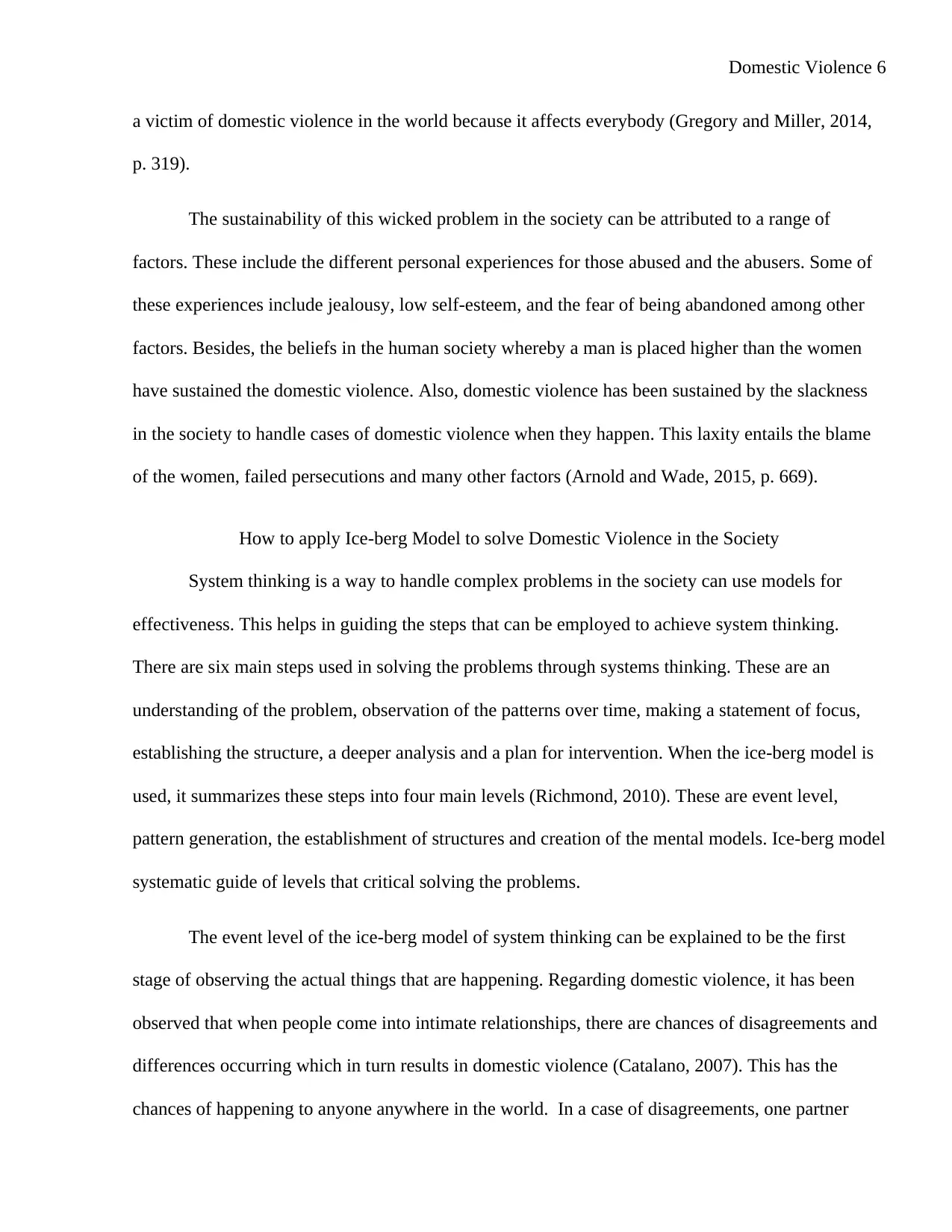
Domestic Violence 6
a victim of domestic violence in the world because it affects everybody (Gregory and Miller, 2014,
p. 319).
The sustainability of this wicked problem in the society can be attributed to a range of
factors. These include the different personal experiences for those abused and the abusers. Some of
these experiences include jealousy, low self-esteem, and the fear of being abandoned among other
factors. Besides, the beliefs in the human society whereby a man is placed higher than the women
have sustained the domestic violence. Also, domestic violence has been sustained by the slackness
in the society to handle cases of domestic violence when they happen. This laxity entails the blame
of the women, failed persecutions and many other factors (Arnold and Wade, 2015, p. 669).
How to apply Ice-berg Model to solve Domestic Violence in the Society
System thinking is a way to handle complex problems in the society can use models for
effectiveness. This helps in guiding the steps that can be employed to achieve system thinking.
There are six main steps used in solving the problems through systems thinking. These are an
understanding of the problem, observation of the patterns over time, making a statement of focus,
establishing the structure, a deeper analysis and a plan for intervention. When the ice-berg model is
used, it summarizes these steps into four main levels (Richmond, 2010). These are event level,
pattern generation, the establishment of structures and creation of the mental models. Ice-berg model
systematic guide of levels that critical solving the problems.
The event level of the ice-berg model of system thinking can be explained to be the first
stage of observing the actual things that are happening. Regarding domestic violence, it has been
observed that when people come into intimate relationships, there are chances of disagreements and
differences occurring which in turn results in domestic violence (Catalano, 2007). This has the
chances of happening to anyone anywhere in the world. In a case of disagreements, one partner
a victim of domestic violence in the world because it affects everybody (Gregory and Miller, 2014,
p. 319).
The sustainability of this wicked problem in the society can be attributed to a range of
factors. These include the different personal experiences for those abused and the abusers. Some of
these experiences include jealousy, low self-esteem, and the fear of being abandoned among other
factors. Besides, the beliefs in the human society whereby a man is placed higher than the women
have sustained the domestic violence. Also, domestic violence has been sustained by the slackness
in the society to handle cases of domestic violence when they happen. This laxity entails the blame
of the women, failed persecutions and many other factors (Arnold and Wade, 2015, p. 669).
How to apply Ice-berg Model to solve Domestic Violence in the Society
System thinking is a way to handle complex problems in the society can use models for
effectiveness. This helps in guiding the steps that can be employed to achieve system thinking.
There are six main steps used in solving the problems through systems thinking. These are an
understanding of the problem, observation of the patterns over time, making a statement of focus,
establishing the structure, a deeper analysis and a plan for intervention. When the ice-berg model is
used, it summarizes these steps into four main levels (Richmond, 2010). These are event level,
pattern generation, the establishment of structures and creation of the mental models. Ice-berg model
systematic guide of levels that critical solving the problems.
The event level of the ice-berg model of system thinking can be explained to be the first
stage of observing the actual things that are happening. Regarding domestic violence, it has been
observed that when people come into intimate relationships, there are chances of disagreements and
differences occurring which in turn results in domestic violence (Catalano, 2007). This has the
chances of happening to anyone anywhere in the world. In a case of disagreements, one partner
⊘ This is a preview!⊘
Do you want full access?
Subscribe today to unlock all pages.

Trusted by 1+ million students worldwide
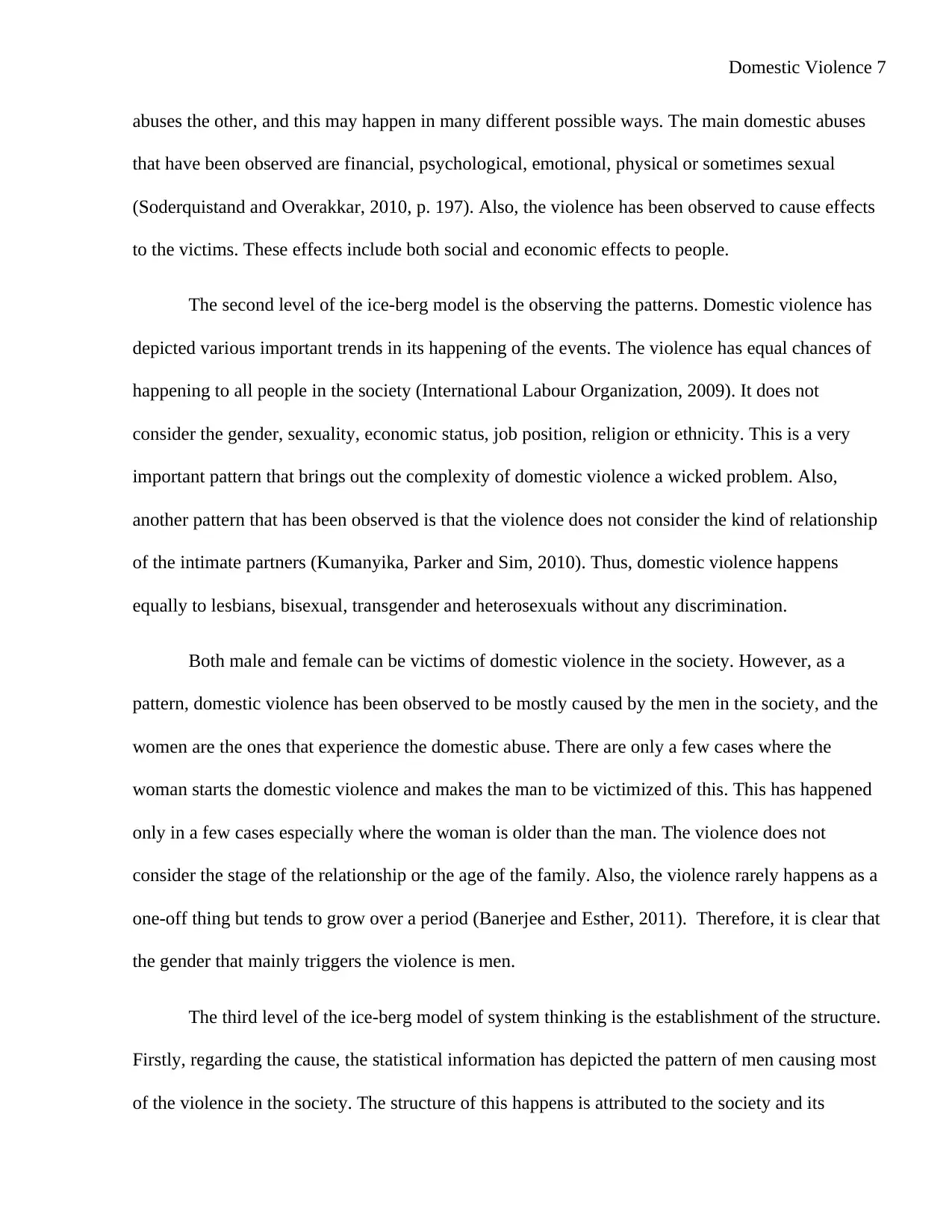
Domestic Violence 7
abuses the other, and this may happen in many different possible ways. The main domestic abuses
that have been observed are financial, psychological, emotional, physical or sometimes sexual
(Soderquistand and Overakkar, 2010, p. 197). Also, the violence has been observed to cause effects
to the victims. These effects include both social and economic effects to people.
The second level of the ice-berg model is the observing the patterns. Domestic violence has
depicted various important trends in its happening of the events. The violence has equal chances of
happening to all people in the society (International Labour Organization, 2009). It does not
consider the gender, sexuality, economic status, job position, religion or ethnicity. This is a very
important pattern that brings out the complexity of domestic violence a wicked problem. Also,
another pattern that has been observed is that the violence does not consider the kind of relationship
of the intimate partners (Kumanyika, Parker and Sim, 2010). Thus, domestic violence happens
equally to lesbians, bisexual, transgender and heterosexuals without any discrimination.
Both male and female can be victims of domestic violence in the society. However, as a
pattern, domestic violence has been observed to be mostly caused by the men in the society, and the
women are the ones that experience the domestic abuse. There are only a few cases where the
woman starts the domestic violence and makes the man to be victimized of this. This has happened
only in a few cases especially where the woman is older than the man. The violence does not
consider the stage of the relationship or the age of the family. Also, the violence rarely happens as a
one-off thing but tends to grow over a period (Banerjee and Esther, 2011). Therefore, it is clear that
the gender that mainly triggers the violence is men.
The third level of the ice-berg model of system thinking is the establishment of the structure.
Firstly, regarding the cause, the statistical information has depicted the pattern of men causing most
of the violence in the society. The structure of this happens is attributed to the society and its
abuses the other, and this may happen in many different possible ways. The main domestic abuses
that have been observed are financial, psychological, emotional, physical or sometimes sexual
(Soderquistand and Overakkar, 2010, p. 197). Also, the violence has been observed to cause effects
to the victims. These effects include both social and economic effects to people.
The second level of the ice-berg model is the observing the patterns. Domestic violence has
depicted various important trends in its happening of the events. The violence has equal chances of
happening to all people in the society (International Labour Organization, 2009). It does not
consider the gender, sexuality, economic status, job position, religion or ethnicity. This is a very
important pattern that brings out the complexity of domestic violence a wicked problem. Also,
another pattern that has been observed is that the violence does not consider the kind of relationship
of the intimate partners (Kumanyika, Parker and Sim, 2010). Thus, domestic violence happens
equally to lesbians, bisexual, transgender and heterosexuals without any discrimination.
Both male and female can be victims of domestic violence in the society. However, as a
pattern, domestic violence has been observed to be mostly caused by the men in the society, and the
women are the ones that experience the domestic abuse. There are only a few cases where the
woman starts the domestic violence and makes the man to be victimized of this. This has happened
only in a few cases especially where the woman is older than the man. The violence does not
consider the stage of the relationship or the age of the family. Also, the violence rarely happens as a
one-off thing but tends to grow over a period (Banerjee and Esther, 2011). Therefore, it is clear that
the gender that mainly triggers the violence is men.
The third level of the ice-berg model of system thinking is the establishment of the structure.
Firstly, regarding the cause, the statistical information has depicted the pattern of men causing most
of the violence in the society. The structure of this happens is attributed to the society and its
Paraphrase This Document
Need a fresh take? Get an instant paraphrase of this document with our AI Paraphraser
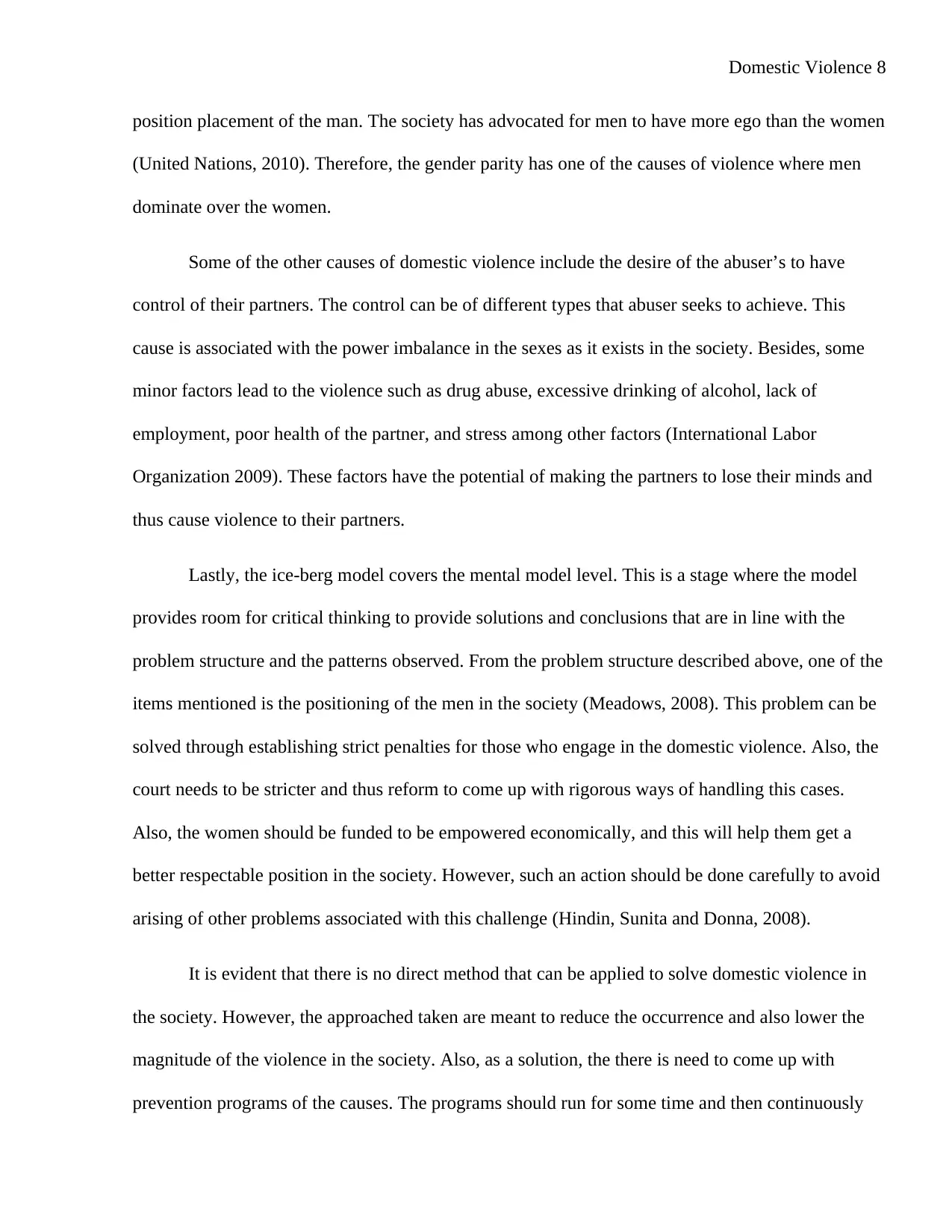
Domestic Violence 8
position placement of the man. The society has advocated for men to have more ego than the women
(United Nations, 2010). Therefore, the gender parity has one of the causes of violence where men
dominate over the women.
Some of the other causes of domestic violence include the desire of the abuser’s to have
control of their partners. The control can be of different types that abuser seeks to achieve. This
cause is associated with the power imbalance in the sexes as it exists in the society. Besides, some
minor factors lead to the violence such as drug abuse, excessive drinking of alcohol, lack of
employment, poor health of the partner, and stress among other factors (International Labor
Organization 2009). These factors have the potential of making the partners to lose their minds and
thus cause violence to their partners.
Lastly, the ice-berg model covers the mental model level. This is a stage where the model
provides room for critical thinking to provide solutions and conclusions that are in line with the
problem structure and the patterns observed. From the problem structure described above, one of the
items mentioned is the positioning of the men in the society (Meadows, 2008). This problem can be
solved through establishing strict penalties for those who engage in the domestic violence. Also, the
court needs to be stricter and thus reform to come up with rigorous ways of handling this cases.
Also, the women should be funded to be empowered economically, and this will help them get a
better respectable position in the society. However, such an action should be done carefully to avoid
arising of other problems associated with this challenge (Hindin, Sunita and Donna, 2008).
It is evident that there is no direct method that can be applied to solve domestic violence in
the society. However, the approached taken are meant to reduce the occurrence and also lower the
magnitude of the violence in the society. Also, as a solution, the there is need to come up with
prevention programs of the causes. The programs should run for some time and then continuously
position placement of the man. The society has advocated for men to have more ego than the women
(United Nations, 2010). Therefore, the gender parity has one of the causes of violence where men
dominate over the women.
Some of the other causes of domestic violence include the desire of the abuser’s to have
control of their partners. The control can be of different types that abuser seeks to achieve. This
cause is associated with the power imbalance in the sexes as it exists in the society. Besides, some
minor factors lead to the violence such as drug abuse, excessive drinking of alcohol, lack of
employment, poor health of the partner, and stress among other factors (International Labor
Organization 2009). These factors have the potential of making the partners to lose their minds and
thus cause violence to their partners.
Lastly, the ice-berg model covers the mental model level. This is a stage where the model
provides room for critical thinking to provide solutions and conclusions that are in line with the
problem structure and the patterns observed. From the problem structure described above, one of the
items mentioned is the positioning of the men in the society (Meadows, 2008). This problem can be
solved through establishing strict penalties for those who engage in the domestic violence. Also, the
court needs to be stricter and thus reform to come up with rigorous ways of handling this cases.
Also, the women should be funded to be empowered economically, and this will help them get a
better respectable position in the society. However, such an action should be done carefully to avoid
arising of other problems associated with this challenge (Hindin, Sunita and Donna, 2008).
It is evident that there is no direct method that can be applied to solve domestic violence in
the society. However, the approached taken are meant to reduce the occurrence and also lower the
magnitude of the violence in the society. Also, as a solution, the there is need to come up with
prevention programs of the causes. The programs should run for some time and then continuously
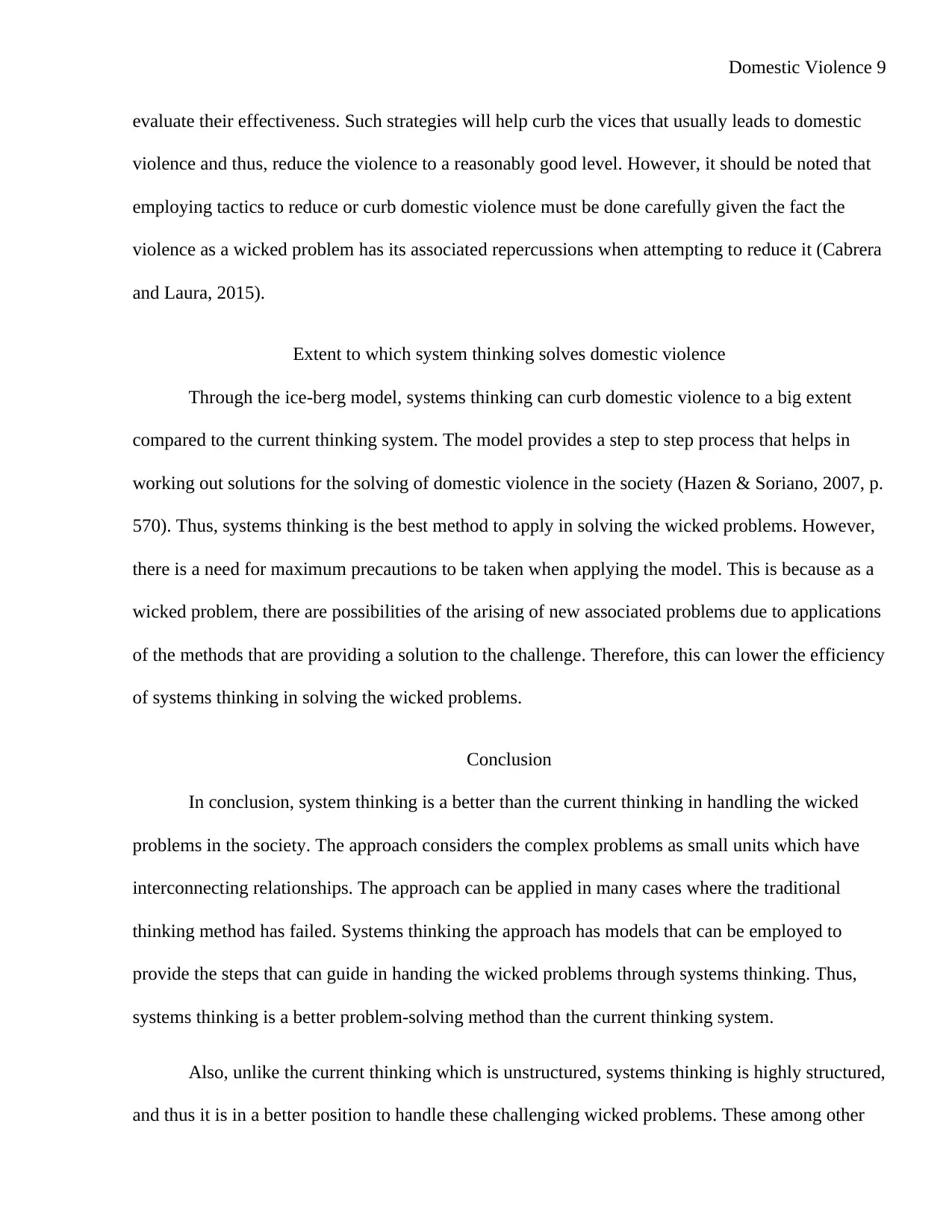
Domestic Violence 9
evaluate their effectiveness. Such strategies will help curb the vices that usually leads to domestic
violence and thus, reduce the violence to a reasonably good level. However, it should be noted that
employing tactics to reduce or curb domestic violence must be done carefully given the fact the
violence as a wicked problem has its associated repercussions when attempting to reduce it (Cabrera
and Laura, 2015).
Extent to which system thinking solves domestic violence
Through the ice-berg model, systems thinking can curb domestic violence to a big extent
compared to the current thinking system. The model provides a step to step process that helps in
working out solutions for the solving of domestic violence in the society (Hazen & Soriano, 2007, p.
570). Thus, systems thinking is the best method to apply in solving the wicked problems. However,
there is a need for maximum precautions to be taken when applying the model. This is because as a
wicked problem, there are possibilities of the arising of new associated problems due to applications
of the methods that are providing a solution to the challenge. Therefore, this can lower the efficiency
of systems thinking in solving the wicked problems.
Conclusion
In conclusion, system thinking is a better than the current thinking in handling the wicked
problems in the society. The approach considers the complex problems as small units which have
interconnecting relationships. The approach can be applied in many cases where the traditional
thinking method has failed. Systems thinking the approach has models that can be employed to
provide the steps that can guide in handing the wicked problems through systems thinking. Thus,
systems thinking is a better problem-solving method than the current thinking system.
Also, unlike the current thinking which is unstructured, systems thinking is highly structured,
and thus it is in a better position to handle these challenging wicked problems. These among other
evaluate their effectiveness. Such strategies will help curb the vices that usually leads to domestic
violence and thus, reduce the violence to a reasonably good level. However, it should be noted that
employing tactics to reduce or curb domestic violence must be done carefully given the fact the
violence as a wicked problem has its associated repercussions when attempting to reduce it (Cabrera
and Laura, 2015).
Extent to which system thinking solves domestic violence
Through the ice-berg model, systems thinking can curb domestic violence to a big extent
compared to the current thinking system. The model provides a step to step process that helps in
working out solutions for the solving of domestic violence in the society (Hazen & Soriano, 2007, p.
570). Thus, systems thinking is the best method to apply in solving the wicked problems. However,
there is a need for maximum precautions to be taken when applying the model. This is because as a
wicked problem, there are possibilities of the arising of new associated problems due to applications
of the methods that are providing a solution to the challenge. Therefore, this can lower the efficiency
of systems thinking in solving the wicked problems.
Conclusion
In conclusion, system thinking is a better than the current thinking in handling the wicked
problems in the society. The approach considers the complex problems as small units which have
interconnecting relationships. The approach can be applied in many cases where the traditional
thinking method has failed. Systems thinking the approach has models that can be employed to
provide the steps that can guide in handing the wicked problems through systems thinking. Thus,
systems thinking is a better problem-solving method than the current thinking system.
Also, unlike the current thinking which is unstructured, systems thinking is highly structured,
and thus it is in a better position to handle these challenging wicked problems. These among other
⊘ This is a preview!⊘
Do you want full access?
Subscribe today to unlock all pages.

Trusted by 1+ million students worldwide

Domestic Violence 10
characteristics have been key in providing the driving force of the systems thinking. However,
systems thinking also has some shortcomings on its side although they are minimal compared to
those of the current thinking. Therefore, system thinking is the appropriate way to handle wicked
changes in the society such as the domestic violence and many others.
characteristics have been key in providing the driving force of the systems thinking. However,
systems thinking also has some shortcomings on its side although they are minimal compared to
those of the current thinking. Therefore, system thinking is the appropriate way to handle wicked
changes in the society such as the domestic violence and many others.
Paraphrase This Document
Need a fresh take? Get an instant paraphrase of this document with our AI Paraphraser
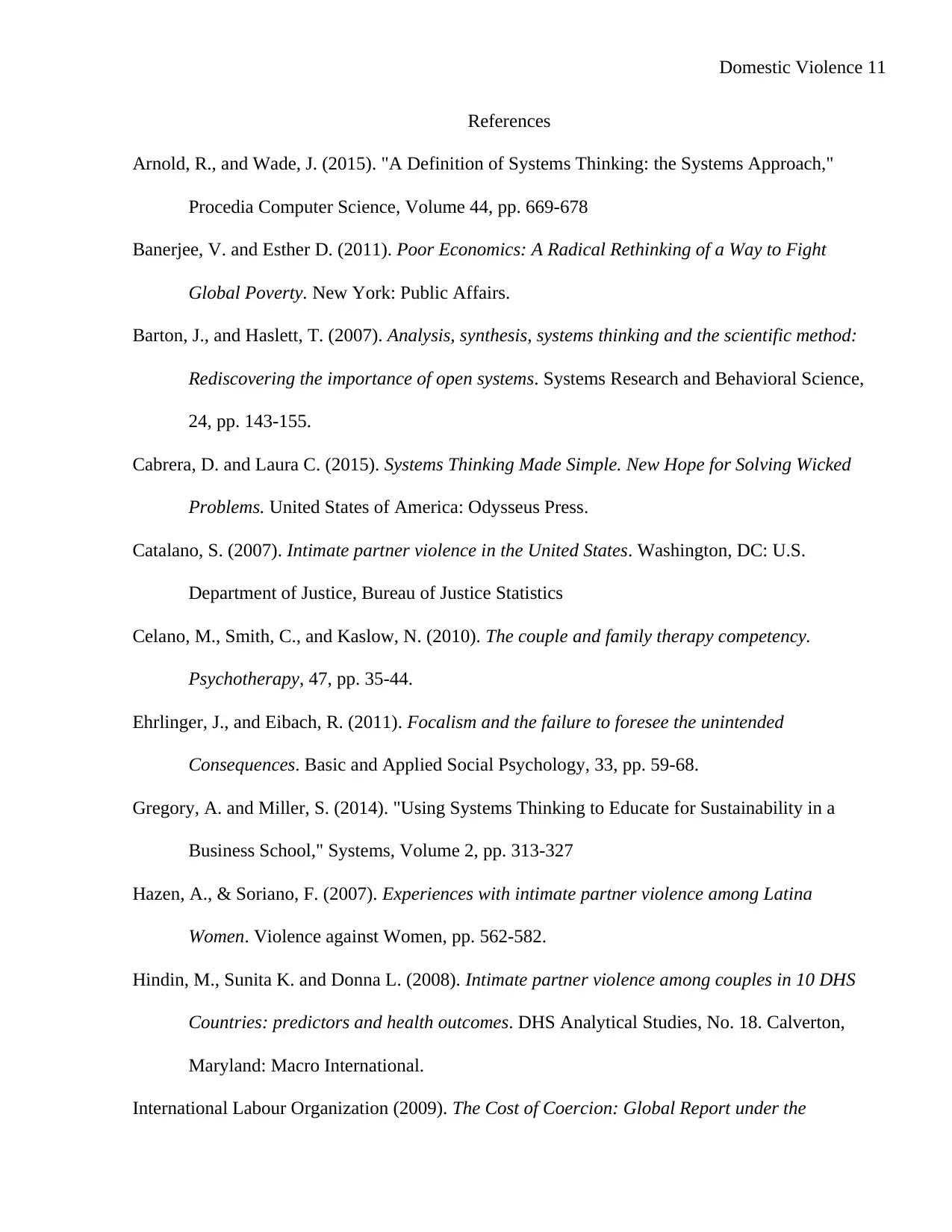
Domestic Violence 11
References
Arnold, R., and Wade, J. (2015). "A Definition of Systems Thinking: the Systems Approach,"
Procedia Computer Science, Volume 44, pp. 669-678
Banerjee, V. and Esther D. (2011). Poor Economics: A Radical Rethinking of a Way to Fight
Global Poverty. New York: Public Affairs.
Barton, J., and Haslett, T. (2007). Analysis, synthesis, systems thinking and the scientific method:
Rediscovering the importance of open systems. Systems Research and Behavioral Science,
24, pp. 143-155.
Cabrera, D. and Laura C. (2015). Systems Thinking Made Simple. New Hope for Solving Wicked
Problems. United States of America: Odysseus Press.
Catalano, S. (2007). Intimate partner violence in the United States. Washington, DC: U.S.
Department of Justice, Bureau of Justice Statistics
Celano, M., Smith, C., and Kaslow, N. (2010). The couple and family therapy competency.
Psychotherapy, 47, pp. 35-44.
Ehrlinger, J., and Eibach, R. (2011). Focalism and the failure to foresee the unintended
Consequences. Basic and Applied Social Psychology, 33, pp. 59-68.
Gregory, A. and Miller, S. (2014). "Using Systems Thinking to Educate for Sustainability in a
Business School," Systems, Volume 2, pp. 313-327
Hazen, A., & Soriano, F. (2007). Experiences with intimate partner violence among Latina
Women. Violence against Women, pp. 562-582.
Hindin, M., Sunita K. and Donna L. (2008). Intimate partner violence among couples in 10 DHS
Countries: predictors and health outcomes. DHS Analytical Studies, No. 18. Calverton,
Maryland: Macro International.
International Labour Organization (2009). The Cost of Coercion: Global Report under the
References
Arnold, R., and Wade, J. (2015). "A Definition of Systems Thinking: the Systems Approach,"
Procedia Computer Science, Volume 44, pp. 669-678
Banerjee, V. and Esther D. (2011). Poor Economics: A Radical Rethinking of a Way to Fight
Global Poverty. New York: Public Affairs.
Barton, J., and Haslett, T. (2007). Analysis, synthesis, systems thinking and the scientific method:
Rediscovering the importance of open systems. Systems Research and Behavioral Science,
24, pp. 143-155.
Cabrera, D. and Laura C. (2015). Systems Thinking Made Simple. New Hope for Solving Wicked
Problems. United States of America: Odysseus Press.
Catalano, S. (2007). Intimate partner violence in the United States. Washington, DC: U.S.
Department of Justice, Bureau of Justice Statistics
Celano, M., Smith, C., and Kaslow, N. (2010). The couple and family therapy competency.
Psychotherapy, 47, pp. 35-44.
Ehrlinger, J., and Eibach, R. (2011). Focalism and the failure to foresee the unintended
Consequences. Basic and Applied Social Psychology, 33, pp. 59-68.
Gregory, A. and Miller, S. (2014). "Using Systems Thinking to Educate for Sustainability in a
Business School," Systems, Volume 2, pp. 313-327
Hazen, A., & Soriano, F. (2007). Experiences with intimate partner violence among Latina
Women. Violence against Women, pp. 562-582.
Hindin, M., Sunita K. and Donna L. (2008). Intimate partner violence among couples in 10 DHS
Countries: predictors and health outcomes. DHS Analytical Studies, No. 18. Calverton,
Maryland: Macro International.
International Labour Organization (2009). The Cost of Coercion: Global Report under the
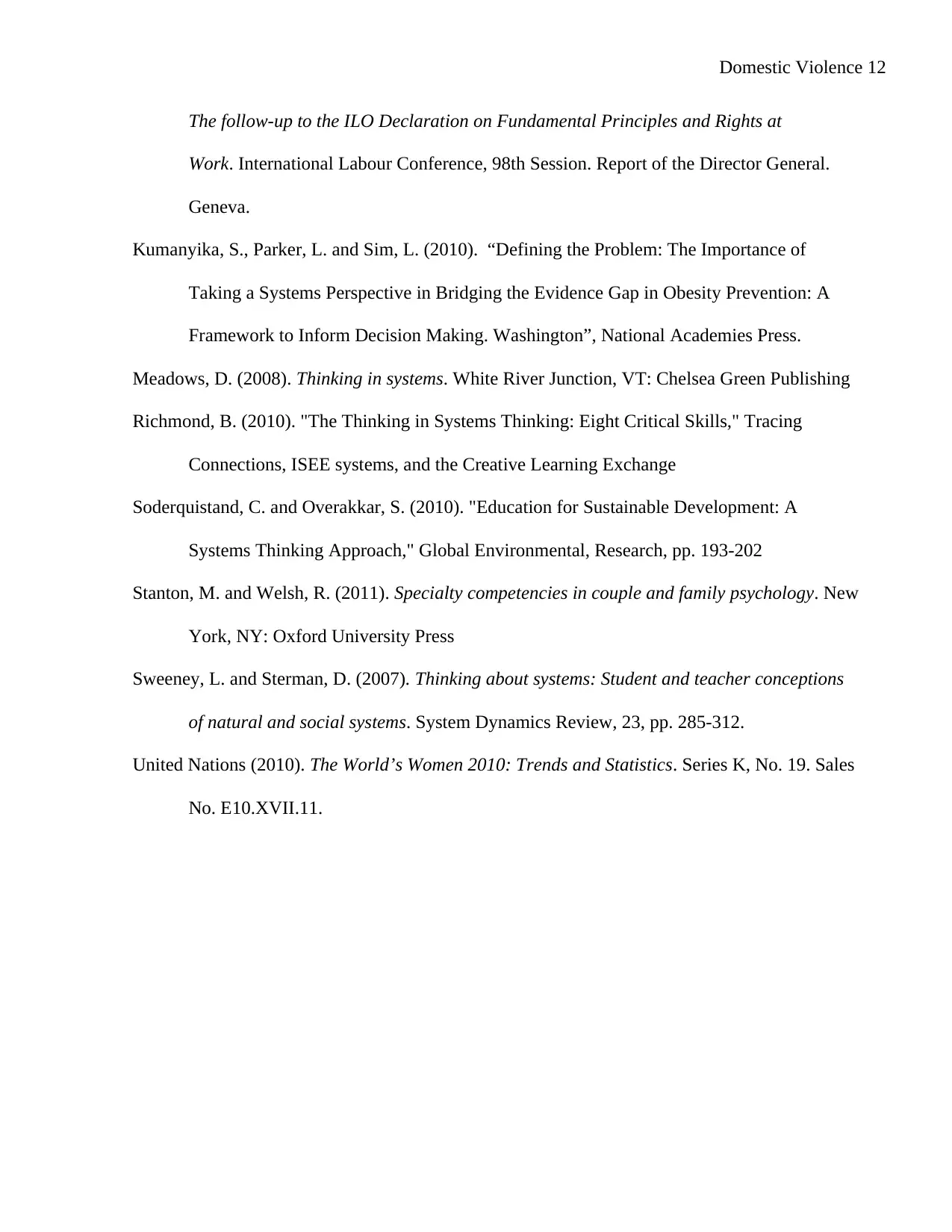
Domestic Violence 12
The follow-up to the ILO Declaration on Fundamental Principles and Rights at
Work. International Labour Conference, 98th Session. Report of the Director General.
Geneva.
Kumanyika, S., Parker, L. and Sim, L. (2010). “Defining the Problem: The Importance of
Taking a Systems Perspective in Bridging the Evidence Gap in Obesity Prevention: A
Framework to Inform Decision Making. Washington”, National Academies Press.
Meadows, D. (2008). Thinking in systems. White River Junction, VT: Chelsea Green Publishing
Richmond, B. (2010). "The Thinking in Systems Thinking: Eight Critical Skills," Tracing
Connections, ISEE systems, and the Creative Learning Exchange
Soderquistand, C. and Overakkar, S. (2010). "Education for Sustainable Development: A
Systems Thinking Approach," Global Environmental, Research, pp. 193-202
Stanton, M. and Welsh, R. (2011). Specialty competencies in couple and family psychology. New
York, NY: Oxford University Press
Sweeney, L. and Sterman, D. (2007). Thinking about systems: Student and teacher conceptions
of natural and social systems. System Dynamics Review, 23, pp. 285-312.
United Nations (2010). The World’s Women 2010: Trends and Statistics. Series K, No. 19. Sales
No. E10.XVII.11.
The follow-up to the ILO Declaration on Fundamental Principles and Rights at
Work. International Labour Conference, 98th Session. Report of the Director General.
Geneva.
Kumanyika, S., Parker, L. and Sim, L. (2010). “Defining the Problem: The Importance of
Taking a Systems Perspective in Bridging the Evidence Gap in Obesity Prevention: A
Framework to Inform Decision Making. Washington”, National Academies Press.
Meadows, D. (2008). Thinking in systems. White River Junction, VT: Chelsea Green Publishing
Richmond, B. (2010). "The Thinking in Systems Thinking: Eight Critical Skills," Tracing
Connections, ISEE systems, and the Creative Learning Exchange
Soderquistand, C. and Overakkar, S. (2010). "Education for Sustainable Development: A
Systems Thinking Approach," Global Environmental, Research, pp. 193-202
Stanton, M. and Welsh, R. (2011). Specialty competencies in couple and family psychology. New
York, NY: Oxford University Press
Sweeney, L. and Sterman, D. (2007). Thinking about systems: Student and teacher conceptions
of natural and social systems. System Dynamics Review, 23, pp. 285-312.
United Nations (2010). The World’s Women 2010: Trends and Statistics. Series K, No. 19. Sales
No. E10.XVII.11.
⊘ This is a preview!⊘
Do you want full access?
Subscribe today to unlock all pages.

Trusted by 1+ million students worldwide
1 out of 12
Related Documents
Your All-in-One AI-Powered Toolkit for Academic Success.
+13062052269
info@desklib.com
Available 24*7 on WhatsApp / Email
![[object Object]](/_next/static/media/star-bottom.7253800d.svg)
Unlock your academic potential
Copyright © 2020–2025 A2Z Services. All Rights Reserved. Developed and managed by ZUCOL.





